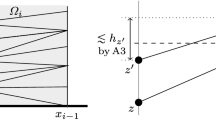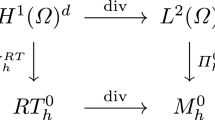Abstract
Consider the Poisson equation on a polyhedral domain with the given data in a weighted \(L^2\) space. We establish new regularity results for the solution with possible vertex and edge singularities and propose anisotropic finite element algorithms approximating the singular solution in the optimal convergence rate. In particular, our numerical method involves anisotropic graded meshes with less geometric constraints but lacking the maximum angle condition. Optimal convergence on such meshes usually requires smoother given data. Thus, a by-product of our result is to extend the application of these anisotropic meshes to broader practical computations by allowing almost-\(L^2\) data. Numerical tests validate the theoretical analysis.






Similar content being viewed by others
References
Apel, T.: Anisotropic Finite Elements: Local Estimates and Applications. Advances in Numerical Mathematics. B. G. Teubner, Stuttgart (1999)
Apel, T., Heinrich, B.: Mesh refinement and windowing near edges for some elliptic problem. SIAM J. Numer. Anal. 31(3), 695–708 (1994)
Apel, T., Nicaise, S.: The finite element method with anisotropic mesh grading for elliptic problems in domains with corners and edges. Math. Methods Appl. Sci. 21, 519–549 (1998)
Apel, T., Schöberl, J.: Multigrid methods for anisotropic edge refinement. SIAM J. Numer. Anal 40(5), 1993–2006 (2002). (electronic)
Apel, T., Sändig, A.-M., Whiteman, J.: Graded mesh refinement and error estimates for finite element solutions of elliptic boundary value problems in non-smooth domains. Math. Methods Appl. Sci. 19(1), 63–85 (1996)
Apel, T., Lombardi, A.L., Winkler, M.: Anisotropic mesh refinement in polyhedral domains: error estimates with data in \(L^2(\Omega )\). ESAIM Math. Model. Numer. Anal. 48(4), 1117–1145 (2014)
Babuška, I., Aziz, A.K.: On the angle condition in the finite element method. SIAM J. Numer. Anal. 13(2), 214–226 (1976)
Bacuta, C., Li, H., Nistor, V.: Anisotropic graded meshes and quasi-optimal rates of convergence for the FEM on polyhedral domains in 3D. In: CCOMAS 2012—European Congress on Computational Methods in Applied Sciences and Engineering, e-Book Full Papers, pp 9003–9014 (2012)
Bacuta, C., Nistor, V., Zikatanov, L.: Improving the rate of convergence of high-order finite elements on polyhedra. II. Mesh refinements and interpolation. Numer. Funct. Anal. Optim. 28(7–8), 775–824 (2007)
Brenner, S., Scott, L.: The Mathematical Theory of Finite Element Methods. Texts in Applied Mathematics, vol. 15, 2nd edn. Springer, New York (2002)
Buffa, A., Costabel, M., Dauge, M.: Anisotropic regularity results for Laplace and Maxwell operators in a polyhedron. C. R. Math. Acad. Sci. Paris 336(7), 565–570 (2003)
Ciarlet, P.: The Finite Element Method for Elliptic Problems. Studies in Mathematics and Its Applications, vol. 4. North-Holland, Amsterdam (1978)
Costabel, M., Dauge, M., Nicaise, S.: Weighted analytic regularity in polyhedra. Comput. Math. Appl. 67(4), 807–817 (2014)
Dauge, M.: Elliptic boundary value problems on corner domains. In: Lecture Notes in Mathematics, vol. 1341. Springer, Berlin (1988)
De Coster, C., Nicaise, S.: Singular behavior of the solution of the Helmholtz equation in weighted \(L^p\)-Sobolev spaces. Adv. Differ. Equ. 16(1–2), 165–198 (2011)
Fritzsch, R.: Optimale finite-elemente-approximationen für Funktionen mit Singularitäten. Thesis (Ph.D.)–TU Dresden (1990)
Gilbarg, D., Trudinger, N.S.: Elliptic Partial Differential Equations of Second Order. Springer, Berlin (1977)
Grisvard, P.: Elliptic Problems in Nonsmooth Domains. Pitman, Boston (1985)
Grisvard, P.: Edge behavior of the solution of an elliptic problem. Math. Nachr. 132, 281–299 (1987)
Kondrat’ev, V.: Boundary value problems for elliptic equations in domains with conical or angular points. Trudy Moskov. Mat. Obšč. 16, 209–292 (1967)
Kozlov, V.A., Maz’ya, V.G., Rossmann, J.: Elliptic Boundary Value Problems in Domains with Point Singularities. Mathematical Surveys and Monographs, vol. 52. American Mathematical Society, Providence (1997)
Křížek, M.: On the maximum angle condition for linear tetrahedral elements. SIAM J. Numer. Anal. 29(2), 513–520 (1992)
Li, H.: An anisotropic finite element method on polyhedral domains: interpolation error analysis. Math. Comput. (2017)
Lions, J.-L., Magenes, E.: Non-homogeneous boundary value problems and applications. Vol. I. Springer-Verlag, New York, 1972. Translated from the French by P. Kenneth, Die Grundlehren der mathematischen Wissenschaften, Band 181 (1972)
Schötzau, D., Schwab, C., Wihler, T.P.: \(hp\)-dGFEM for second-order mixed elliptic problems in polyhedra. Math. Comp. 85(299), 1051–1083 (2016)
Acknowledgements
The first author was supported in part by the NSF Grant DMS-1418853, by the Natural Science Foundation of China (NSFC) Grant 11628104, and by the Wayne State University Grants Plus Program.
Author information
Authors and Affiliations
Corresponding author
Appendix
Appendix
We here illustrate that the numerical convergence rate in (89) is a reasonable indicator for the actual convergence rate. Assume
where \(0<s\le 1\) is the convergence rate and \(C>0\) is independent of j. Recall the Galerkin orthogonality
Then,
and
Therefore, we have
This leads to \(|u_{j}-u_{j-1}|_{H^1(\Omega )}=\sqrt{1-2^{-2s}}C 2^{s(1-j)}\). Hence,
In the same manner, one can show that if
then
Rights and permissions
About this article
Cite this article
Li, H., Nicaise, S. Regularity and a priori error analysis on anisotropic meshes of a Dirichlet problem in polyhedral domains. Numer. Math. 139, 47–92 (2018). https://doi.org/10.1007/s00211-017-0936-0
Received:
Revised:
Published:
Issue Date:
DOI: https://doi.org/10.1007/s00211-017-0936-0




